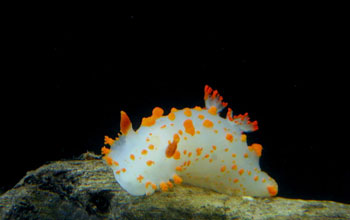Multimedia Gallery
Marine Life of California's Rocky Shores (Image 62)
Nudibranch (Triopha catalinae).
There are over 100 species of nudibranchia in California and each has its own unique and interesting story. Many are brightly colored, but some blend into their surroundings or match their prey (upon which they may live). These are such beautiful creatures--it is hard to imagine that some animals find them toxic.
This is just one of the thousands of "tidepool treasures," marine plants and animals found in the small bodies of water left by the ebbing tides that fill the rock basins and depressions along California's rocky shores. [Image 62 in a series. See Image 63.]
More about this series
This series of images examines various marine life that can be found in the different sea levels, or zones, of the rocky shores of the California coast. The images were photographed by Genevieve (Genny) Anderson of the Biological Sciences Department, Santa Barbara City College, as part of her ongoing research on the subject.
Rocky shores provide a stable substrate for plant and animal life and organisms, as opposed to sandy beaches where the substrate (sand) is constantly moving. When the tide goes out then the influences of the air and weather (sun, rain, snow) begin to play important roles--more with the higher zones.
At any tide level on a rocky shore, a pool of water--called tidepools--can be left with the receding tide. These pools provide welcome ocean water for marine life left high and dry with a receding tide. The pools highest in the intertidal may become very hot due to the sun, which may not be comfortable for some species. The pools closest to the low tide have the least influence from the air and weather, and have the greatest variety of marine life. These tidepools often mirror what is actually subtidal (below the lowest low tide, as opposed to intertidal which is between the tides). As the water goes down, most of the ocean creatures go out with it, but some can't move and are left on rocks. These creatures must adapt to withstand not only the dryness of their area, but waves, storms, wind and rain. It is their ability to withstand dryness and their interactions with each other (eating, being eaten, competing for space and reproducing) that determines who dominates within the rocky intertidal areas.
In examining the marine life on the exposed rocky surfaces of California's shores, it is easiest to look at these surfaces in "zones." Above 5 feet, the surface is covered only by the highest high tide and thus dry three-quarters of the day. This is called the "Splash" Zone. Then, between 5 feet and 2 1/2 feet, the surface is covered alternately by both high tides so it is dry between them--about half a day. This band is called the "High Tide" Zone. Between sea level and 2 1/2 feet the rocks are only left dry at the low, low tide. This area is thus dry only a quarter of each average day and called the "Mid Tide" Zone. Then there is what's called the "Low Tide" Zone, the area below sea level that is exposed for only a few hours every few weeks at special "minus" tides (remember, 0 sea level is the average of the low, low tides).
To learn more about Genevieve (Genny) Anderson's research on marine life along California's rocky shores, visit her website, "Tidepools (California)." Anderson, who has been a teacher of marine biology and biological oceanography at Santa Barbara City College for over 30 years, has other interesting lesson plans and lecture materials available Here.
Credit: Genny Anderson, Santa Barbara City College
See other images like this on your iPhone or iPad download NSF Science Zone on the Apple App Store.
Images and other media in the National Science Foundation Multimedia Gallery are available for use in print and electronic material by NSF employees, members of the media, university staff, teachers and the general public. All media in the gallery are intended for personal, educational and nonprofit/non-commercial use only.
Images credited to the National Science Foundation, a federal agency, are in the public domain. The images were created by employees of the United States Government as part of their official duties or prepared by contractors as "works for hire" for NSF. You may freely use NSF-credited images and, at your discretion, credit NSF with a "Courtesy: National Science Foundation" notation.
Additional information about general usage can be found in Conditions.
Also Available:
Download the high-resolution JPG version of the image. (103 KB)
Use your mouse to right-click (Mac users may need to Ctrl-click) the link above and choose the option that will save the file or target to your computer.

